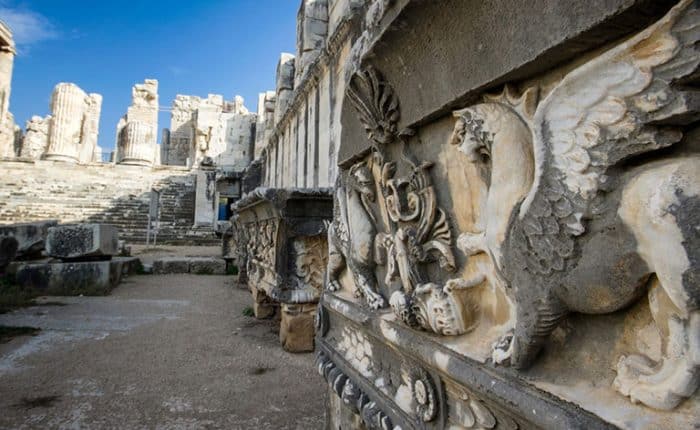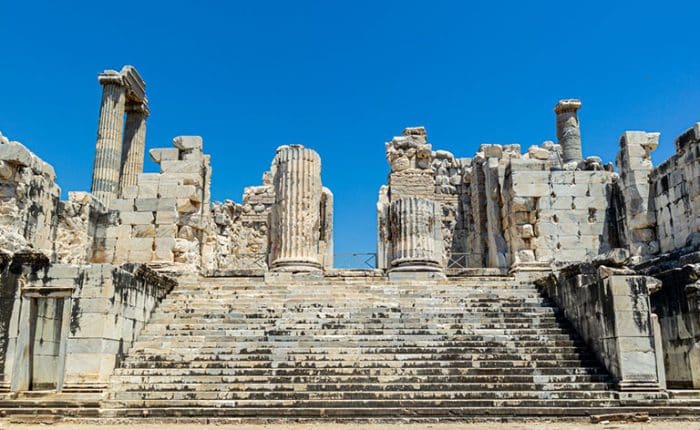Didyma was inhabited as early as the Neolithic times, and for the next millennium or two, it attracted settlers from Crete and Mycenae. But throughout its known history, Didyma was less of a settlement and more of a religious establishment. Even its most illustrious periods were enjoyed with it as a spiritual center.
All this can be attributed to a single sping considered sacred by the surrounding populations. So, when the Greek settlers arrived on the Aegean shores, they adopted this belief and constructed a temple around the spring of the 8th century BCE. Thus began the story of Didyma.
The sacred courtyard of the temple featured an altar and a laurel tree dedicated to Apollo. On the other hand, water from the spring was used for prophetic activities. This temple was upgraded, destroyed, and upgraded again throughout its existence. It remained an important location to the surrounding cities, especially Mellitus, throughout the Archaic, Hellenistic, and Roman times.
Didyma then became the site of a Christian church in the Byzantine era. And like most other ancient sites in the region, this was also when its significance began to wane. It briefly served as a bishopric during the reign of Emperor Justinian, but its decline seemed to have been set in stone.
In the 7th century, an earthquake devastated the region. And although it became the seat of the bishop again from the 10th to the 12th century CE, the arrival of the Turks and the Ottoman Empire meant it would never become more important than that. A 15th-century earthquake was the final nail in the coffin for Didyma- it was abandoned and lay forgotten until the 18th century.
The Temple of Apollo was the most defining feature of Didyma. This made it a popular pilgrimage site 2500 years ago and a popular tourist destination today. Pilgrims from the archaic and Hellenistic era would travel from Miletus along the Sacred Way to come and listen to prophetic messages from the oracle.
Three temples have stood here throughout history, each one progressively grander than the last.
The first was a small 8th century BCE structure built by the first Greek settlers. By 550 BCE, a mighty temple with a bronze statue of Apollo had already been built in its place. This was the Archaic Didymaion and was constructed in the form of a dipteros, i.e., a building surrounded by an Ionic order double colonnade.
The temple measured 85 by 38 meters, with an outer colonnade of 21 columns on the long side, nine on the western side, and eight on the eastern side. The eastern columns were spaced such that a broader transition between columns was possible, creating an impression of a gate leading into the temple.
This sanctuary didn’t so much belong to Didyma as it did to the neighboring city of Miletus. Like Didyma, it existed as a testament to the glory of Miletus. This would be the cause of its downfall, as in 493 BCE, the Persians would destroy the temple in response to its parent city’s role in the rebellion of the Ionian city.
The Macedonians eventually liberated the region from the firm Persian grip that lasted for over a century. Then, with the help of Alexander the Great, the Temple of Apollo was reconstructed to make it the largest of its kind. Had it been completed, the temple would’ve been more significant than the temple of Artemis at Ephesus.
Unfortunately, that didn’t happen, and the temple stood incomplete for the rest of its existence. Still, it was an incredible feat of architecture, and its ruins are what we observe today. In its full glory, this temple featured a monumental staircase with 108 columns surrounding the temple and another 18 decorating the inside the sanctuary.
The Society of Dilettanti sent two expeditions to look for Didyma. After its discovery, the first excavations were conducted in 1858 by British archeologists led by Charles Thomas Newton. Subsequent excavations by the French in 1872 and 1895-1896 uncovered the Hellenistic Temple of Apollo.
More of the sanctuary was dug up between 1905 and 1937 by German archeologists from Berlin museums. Finally, fresh excavations began in 1962 under the German Archeological Institute. These works continue with special attention paid to the Sacred Way.
In 1979, German researchers discovered plans for the unfinished Didymaion on the inner lines of the courtyard. These plans allow us to deduce the planned scale of this once-great Ionic temple.



The sanctuary at Didyma lived in the shadow of the temple of Artemis for much of its history. But today, it has stepped out of that shadow in spectacular function, providing an exciting experience to visitors, tourists, and locals alike.
There isn’t a whole city to explore here. Instead, it’s a site of collapsed ruins full of architectural surprises that will test your imagination and reveal some of the best-kept secrets of ancient Greek temple architecture.
You can visit Didyma, Miletus, and Priene all in one day. There is also the ancient city of Ephesus and other Lydian ruins in the area. The town of Didyma has lots of beautiful beaches and resorts where you can enjoy some lazy time when not exploring the surrounding areas.